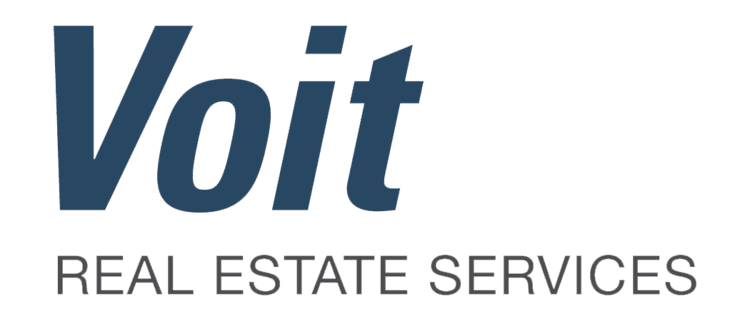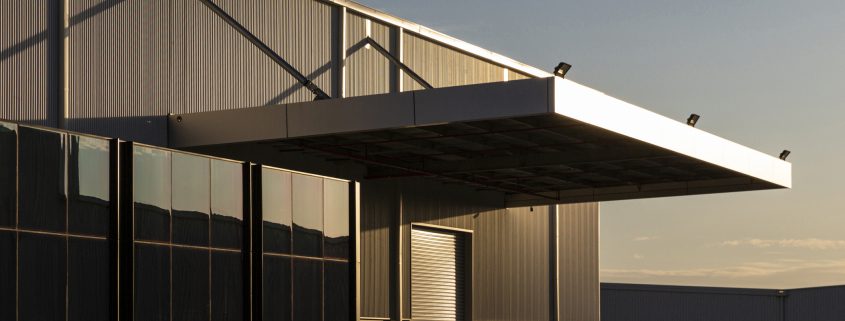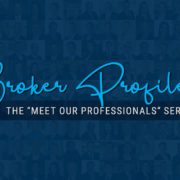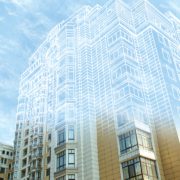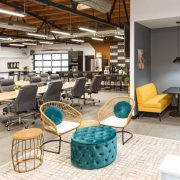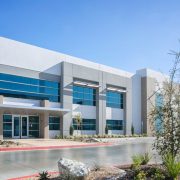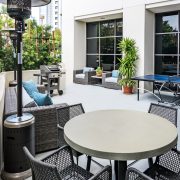The Impact of Higher Mortgage Rates on PID Owner-User Buildings
The concept first became popular in the 1970s when developer Dunn Properties decided to sell individual buildings in their projects after experiencing sluggish lease-up activity.
Dunn Properties were surprisingly successful in that effort, which changed the industrial landscape—literally.
What is a Planned Industrial Development?
Today, we see dozens of small building projects throughout San Diego County known as Planned Industrial Developments (PIDs).
There are several reasons for Dunn’s serendipitous success. Owning versus leasing benefits include:
- Controlling long-term occupancy costs
- Diversifying personal investment portfolios
- And building equity through price appreciation and principal pay-down of debt
Simply put, many small business owners choose to build wealth for themselves rather than their landlords.
Since Dunn made their first sale offerings, individual fortunes have been made, and due to this real estate cycle’s massive price rise, those fortunes are, in many instances, beyond the wildest dreams of PID owners.
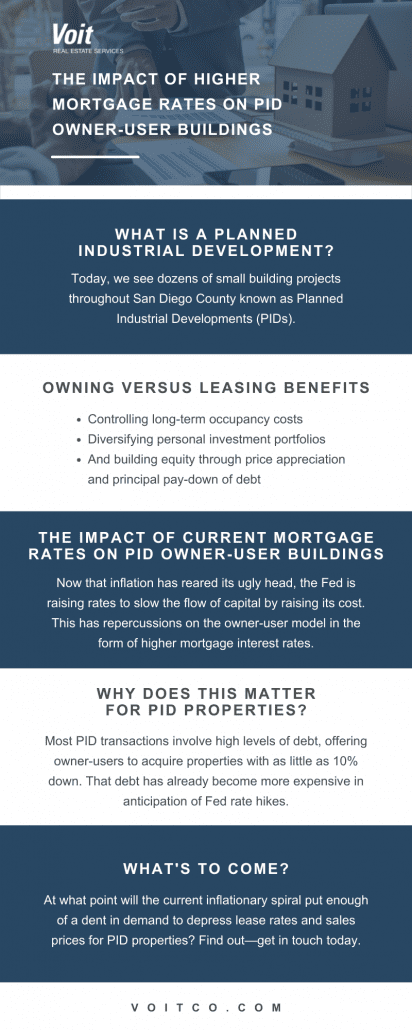
The Impact of Current Mortgage Rates on PID Owner-User Buildings
The prolific run-up in pricing that we have experienced has two basic components: undersupply of PID inventory and the lowest mortgage rates in American history.
To lift the country out of the so-called Great Recession, the nation’s central bank lowered its benchmark Fed Funds Rate to zero to stimulate the flow of capital by reducing its cost, and then began electronically printing money to buy US sovereign debt held by banks to free up excess reserves to make more loans, mortgages included.
But, now that inflation has reared its ugly head again, the Fed is reversing course to slow it down by raising rates to slow the flow of capital by raising its cost. This has repercussions on the owner-user model in the form of higher mortgage interest rates.
For PID properties, this is particularly important because most PID transactions involve high levels of debt, offering owner-users to acquire properties with as little as 10% down. That debt has already become more expensive in anticipation of Fed rate hikes, the first of which came in March 2022.
For example, the SBA 504 loan, the most commonly used in PID transactions, has gone from 2.4% a year ago to 3.92% today. In just a few months, the 504 rate has risen 66 basis points. That’s a 20% rise in 60 days.
Higher rates mean higher interest cost for each dollar borrowed, and that means one of the primary price supports for PID property values is weakening. The other, low supply, continues. That has, thus far, kept prices moving up, as there are too many buyers chasing too few properties available for acquisition.
The Opportunity to Become a PID Owner
However, we are now hearing more small business owners express concerns over being priced out of their opportunities to become PID owners.
On the leasing side, low supply has kept lease rates moving up, as well. So, comparatively speaking, the cost between buying versus leasing is relatively unchanged for the time being.
That means the owner-user decision, while more expensive than before, is still a viable option. The question is: At what point will the current inflationary spiral put enough of a dent in demand to depress lease rates and sales prices for PID properties?
We don’t have an exact answer to that question, but we can look at history and conclude that such a time might be coming sooner rather than later.
PID History
The more aggressive the Fed gets with reversing its long run of easy money policies, the sooner that time could come. The last time the Fed battled inflation like we have today, ended in a painful recession. If you were around in the late 1970s and early 1980s you probably have a vivid memory of just how difficult a time that was.
Preparing for What’s to Come
Are we certain to suffer a similar fate? No one knows for sure.
But, we appear to be heading in that direction, and business owners are wise to prepare themselves for tougher times ahead.
Our current situation may be a signal to buyers with a long-term perspective to buy now while rates are relatively low, so they can lock in lower occupancy costs through the next real estate cycle. Or, it may be a reason for them to hold off on a purchase to retain capital they may need access to if the economy stumbles. Every business is different, but the result of each decision affects us all when aggregated.
For PID owners who are sitting on highly appreciated assets, this may be a good time to dispose of their properties at or near a market peak and reallocate their gains to fund retirement or reinvest in other asset classes to diversify their portfolios and reduce their risk.
Again, every owner’s circumstances are unique and contain quality of life components that should be taken into serious consideration.
One thing we do know for sure is that planning ahead is a far better option than waiting for a problem to manifest before taking action. Strategic planning creates multiple paths to good outcomes and protects against being forced to act defensively. Your Voit professional can assist you in developing a real estate strategy that reflects current trends and likely changes to market conditions.
Read on to learn more about the San Diego CRE marketing, including 2022 office leasing trends.
*Disclaimer: This article was originally written in March 2022. This considered, the content of this article is subject to change and may not be entirely accurate depending on its posting date, additional interest rate changes, etc.
